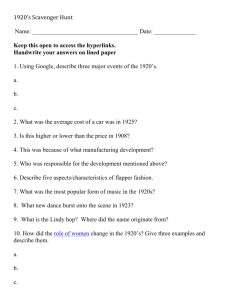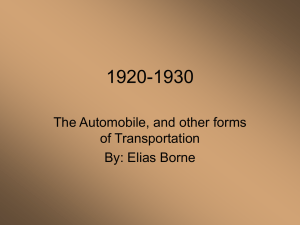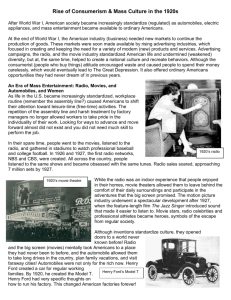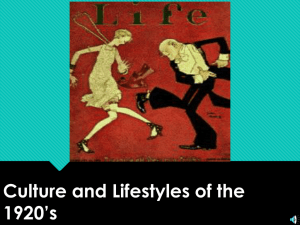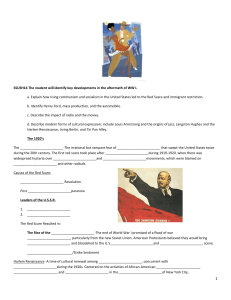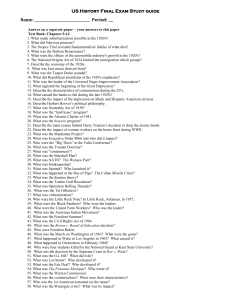Chapter 3 Prosperity : Fact or Myth
advertisement
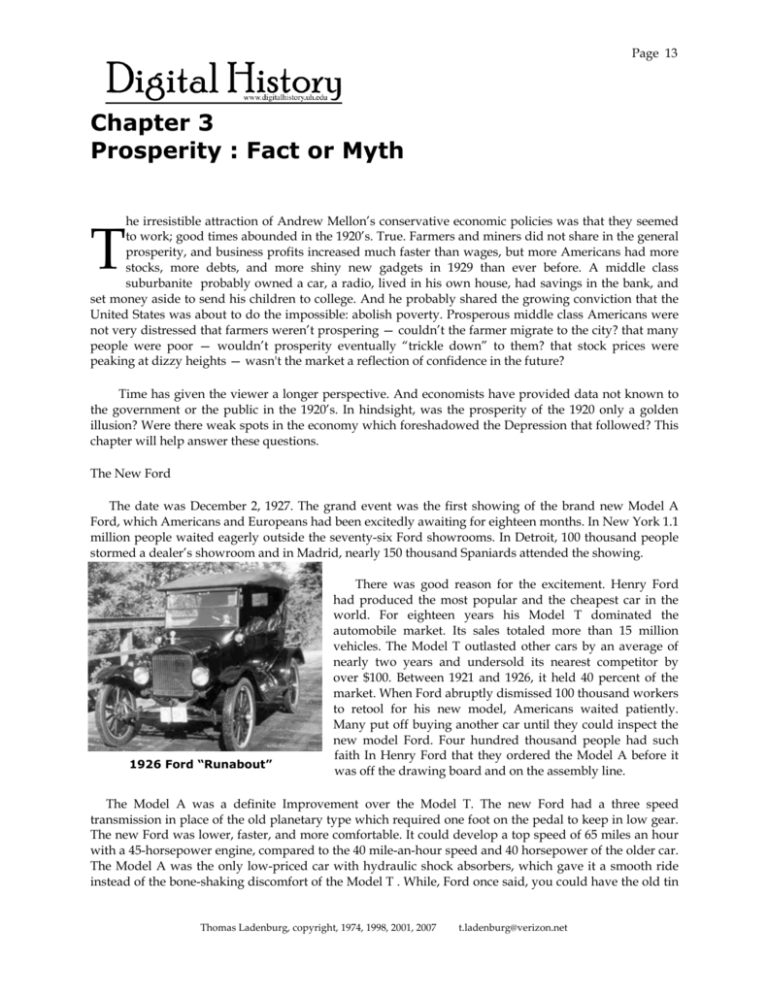
Page 13 Chapter 3 Prosperity : Fact or Myth he irresistible attraction of Andrew Mellon’s conservative economic policies was that they seemed to work; good times abounded in the 1920’s. True. Farmers and miners did not share in the general prosperity, and business profits increased much faster than wages, but more Americans had more stocks, more debts, and more shiny new gadgets in 1929 than ever before. A middle class suburbanite probably owned a car, a radio, lived in his own house, had savings in the bank, and set money aside to send his children to college. And he probably shared the growing conviction that the United States was about to do the impossible: abolish poverty. Prosperous middle class Americans were not very distressed that farmers weren’t prospering — couldn’t the farmer migrate to the city? that many people were poor — wouldn’t prosperity eventually “trickle down” to them? that stock prices were peaking at dizzy heights — wasn't the market a reflection of confidence in the future? T Time has given the viewer a longer perspective. And economists have provided data not known to the government or the public in the 1920’s. In hindsight, was the prosperity of the 1920 only a golden illusion? Were there weak spots in the economy which foreshadowed the Depression that followed? This chapter will help answer these questions. The New Ford The date was December 2, 1927. The grand event was the first showing of the brand new Model A Ford, which Americans and Europeans had been excitedly awaiting for eighteen months. In New York 1.1 million people waited eagerly outside the seventy-six Ford showrooms. In Detroit, 100 thousand people stormed a dealer’s showroom and in Madrid, nearly 150 thousand Spaniards attended the showing. 1926 Ford “Runabout” There was good reason for the excitement. Henry Ford had produced the most popular and the cheapest car in the world. For eighteen years his Model T dominated the automobile market. Its sales totaled more than 15 million vehicles. The Model T outlasted other cars by an average of nearly two years and undersold its nearest competitor by over $100. Between 1921 and 1926, it held 40 percent of the market. When Ford abruptly dismissed 100 thousand workers to retool for his new model, Americans waited patiently. Many put off buying another car until they could inspect the new model Ford. Four hundred thousand people had such faith In Henry Ford that they ordered the Model A before it was off the drawing board and on the assembly line. The Model A was a definite Improvement over the Model T. The new Ford had a three speed transmission in place of the old planetary type which required one foot on the pedal to keep in low gear. The new Ford was lower, faster, and more comfortable. It could develop a top speed of 65 miles an hour with a 45-horsepower engine, compared to the 40 mile-an-hour speed and 40 horsepower of the older car. The Model A was the only low-priced car with hydraulic shock absorbers, which gave it a smooth ride instead of the bone-shaking discomfort of the Model T . While, Ford once said, you could have the old tin Thomas Ladenburg, copyright, 1974, 1998, 2001, 2007 t.ladenburg@verizon.net Page 14 lizzy in any color you wished so long as you wanted black, the new Ford was available In Niagara and gun blue, Dawn gray and Arabian sand. The price of the new car was almost the same as the old. New Yorkers were so favorably impressed that on the first day they ordered 50 thousand. More and Better Cars In 1919, 6,771,074 passenger vehicles were registered in the United States. Ten years later this figure had leapt to 23,122,100, almost one car per family. Indeed, as surveys showed, many families bought cars before they installed bathtubs. The cars of 1929 were cheaper than those of 1919, averaging $621 — compared to $888; they were also better, faster, and flashier. Production in 1929 reached over 4.58 million vehicles, tripling the 1919 mark. Americans produced seven-eighths of the worlds’ cars, exporting onehalf million vehicles each year. With an average of 4.6 persons per car, the United States far outdistanced all other nations in automobile ownership. Impact of the Automobile The shoe industry felt the impact of the automobile — people rode rather than walked, and wore out tires instead of shoes. The railroads found they couldn’t compete with cars, buses, and trucks, and began their long decline. But the automobiles did require replacement parts and services. Filling stations came to decorate the landscape, accompanied by billboards, roadside hot dog stands, restaurants, and camp sites. The automobile motorized crime; bootleggers ran whiskey hidden under the seats of old Fords, bank robbers could attempt their getaways in stolen Pierce Arrows, pursued by policemen in hopped-up Chevys. Americans discovered they could live farther from the center of cities and hastened their long motor cavalcade toward suburbia. Farmers marketed eggs in the backs of their old Model Ts and trucked vegetables and dairy products to the cities. Even courtship patterns were greatly influenced by the automobile; the car replaced the parlor the place where pleading suitors “popped the question,” and parents feared for the virtue of their daughters when suitors appeared sporting flashy automobiles. By 1926, Americans were spending $6 billion yearly on purchases connected with their new motorized toys. Production of automobiles alone accounted for 12.7 percent of all manufacturing done in the country. Motor vehicles consumed 85 percent of our rubber imports, 67 percent of our plate glass, 19 percent of our iron and steel, and healthy percentages of our copper, hardwood, lumber, and lead. Ten percent of the country’s labor force was employed In making cars. Millions were lavished on developments stimulated by the automobile. State and federal governments spent $1 billion annually building roads; local and city governments contributed half that. Thousands of additional developments were fostered by the automobile. Restaurants, resorts, tourist camps, and vacation spots were built to serve the customers brought by the automobile from all over the country. Small wonder that economists have pronounced the automobile the main prop under the economy.’ Thomas Ladenburg, copyright, 1974, 1998, 2001, 2007 t.ladenburg@verizon.net Page 15 Other products, however, also sparked economic development. Primary among these were radios and movies. In 1920, the first radio sets appeared on the market. By 1922, sales totaled $60 million, but the craze had not yet really caught on. Over the next two years, sales more than doubled, and by 1929, Americans had spent 3.4 billion on radios. The radio story was repeated, though less dramatically, by countless other industries. Everywhere one looked new and improved products and gadgets began competing for the dollar. Movie makers glamorized their products by introducing the public to stars such as Douglas Fairbanks and Mary Pickford, wooing all America into new film palaces. The new electric power industry shared in the prosperity, along with rayons, cosmetics, cigarettes, telephones, refrigerators, and airplanes. Here lay the foundations of American affluence. Production, Profits and Wages leadership, with a profit rate of 19.7 percent was Between 1920 and 1929, national income shot up by $22 billion to 882 billion. Productivity, the amount working hour, increased by 25 percent during the of 3.5 percent a year. This gain in the worker’s permitted a 15 per cent per capita gain in real wages, between 1920 and 1923. It also allowed for increased a 62 percent rise in corporate earnings, and a doubling payments. America’s claim to prosperity during the 1920’s, and the automobile industry’s undisputed. billion, from $60 produced in each 1920’s, at a rate efficiency mostly recorded business. profits, of dividend During the 1920’s the average American’s income percent. This gave him/her the money to purchase 27 automobiles, and 3.5 million new homes. Nine million wired for electricity, 6 million phones were installed; 7 were sold. School and college enrollments increased 75 Dow Jones Industrial course not all of this was paid for; mortgages aside, Avg. purchases increased by 6 billion. This increase in however, was balanced by a doubling of savings during the 1920’ Thomas Ladenburg, copyright, 1974, 1998, 2001, 2007 t.ladenburg@verizon.net went up by 20 million homes were million radios percent. Of installment indebtedness, Page 16 The Stock Market Jumps A stock market boom was built on the foundations of the wealth and optimism of the 1920’s. Nourished by corporate profits and as well as by government policies, stock prices began rising. Between 1921 and 1925 prices of common stock doubled. But the market had not yet become America’s great passion; it did not make news considered worthy of front-page coverage and was content with trading a million shares a day. In 1927, however, speculators started paying earnest attention to the market, and they saw great possibilities. As they started buying heavily, the market shot skyward, with some stocks vaulting ten or twenty points in a single day. By 1928, common stocks averaged three times their 1921 values and still were being bid up. The market, many insiders thought, had reached a permanently high plateau. Brokers, bankers, and even government officials assured the public that stocks were not too high and would keep going up. Over 1 million Americans became financially committed to the market. Many had invested their life’s savings; an estimated 600 thousand had borrowed to pay for their shares of stock. Stock sales regularly exceeded 5 million shares a day and the market was often front-page news. Profits were not made on the dividends paid by the corporations but on the increases in the market value of the shares themselves. So much money was being made on the market that many businesses found it more profitable to buy stocks in other corporations than to expand production. By 1929, common stocks sold for four times their 1921 prices, but no one worried, for the country had been suffering a depression in 1921 and now was riding high on a crest of prosperity. Stock values, it was thought, reflected the condition of the American economy. And, in a way, perhaps they did. Prosperity is Uneven The casual observer could uncover other signs of abundance. The number of people paying taxes on incomes of $1 million or more was rapidly increasing. In 1924, only seventy-five men were able to declare million-dollar incomes; three years later, this number had risen to 283. But the gains of the wealthy were not limited to a select class of millionaires. The 1 percent earning most money found their share of income was increasing to about 14 percent during the 1920’s; those in the upper 5 percent were recording a greater gain, and by 1929 received over 25 percent of all the nation’s income. Indeed, Americans were suffering a distribution problem. The richest 36,000 families had incomes equivalent to the earnings of the poorest 12 million. But these figures did not shock very many, for it was thought the poor were also getting wealthier, though, admittedly at a slower rate. Yet, many Americans could not help but see the blemishes in this picture. Not everyone was prosperous. Certainly not the farmers, who were buried under a surplus of wheat, cotton, or corn; nor the miners, who found the need for coal slacking while unsold surpluses mounted. Textile and leather workers, too, were overproducing and could not command prosperity wages. Doctors and lawyers in 1929 had average net incomes a bit over $5000. The best-paid city school teachers received $2000 or more, but rural grade-school and many teachers received as little income as workmen, who averaged only $1500. Estimates of a family minimum income necessary for “health and decency” ranged between $1820 and $2080. Not everything glittered in the Golden Twenties. In 1929 1,900 rubber workers in Hartford and New Haven lost their jobs because production was shifted to more efficient factories run elsewhere by the same companies. After eleven months, 13 percent of these men were still looking for work, and 66 percent had to accept lower-paying positions. They could take small comfort in the knowledge they were not alone. Increased industrial efficiency, call it technological unemployment or automation, had eliminated over 3.25 million jobs during the 1920’s, or about 900 jobs each day for ten years. Though most displaced workers were eventually able to find employment, this usually meant months of searching and eventually settling for lower wages. Since the working force grew faster than the number of new jobs, Thomas Ladenburg, copyright, 1974, 1998, 2001, 2007 t.ladenburg@verizon.net Page 17 looking for work seemed more and more like a game of musical chairs — when the music stopped there just weren’t enough places for everyone. Fact or Myth In 1928, Herbert Hoover, the Republican presidential candidate, predicted that the United States was nearing the time when it would conquer poverty. Hoover pointed proudly to the statistics showing that national income was rising and concluded that more Americans were enjoying more of the material rewards of life than ever before. The future looked rosy, and Hoover credited the conservative policies of the past eight years. The nation endorsed his judgment with a resounding vote of confidence in the November presidential election of 1928 Suggested student exercises: 1. Assess the impact of the automobile on American society, including its social as well as its economic impact. 2. Make a list, and put at least four facts in each of the following three categories - one has already been presented in each as an examples. Was Prosperity Real or False: Facts showing it was: Real Not sure what they indicate False National income went up by Stock market had gone up People at the bottom were 22 billion dollars 400% in 8 years increasingly getting smaller % of national income 3. Based on your analysis does the majority of the evidence prove that prosperity was real and likely to continue, false, the U.S. was heading for a major collapse, or is it simply too difficult to make a prediction? Support your answer. Thomas Ladenburg, copyright, 1974, 1998, 2001, 2007 t.ladenburg@verizon.net


